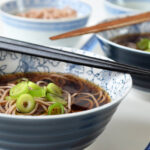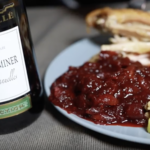 The consumption of soba noodles is practically a cult in Japan, with its own history, lore, rituals and rules. We haven’t reached that stage of connoisseurship in the U.S.—but soba is now widely available in Japanese restaurants here, and there are even a few restaurants, à la Tokyo, devoted exclusively to soba. The noodles are made from buckwheat flour, and this may be why they inspire such passion: they are firmer, more textured, more flavorful than most other noodles of the world. The noodles may be either freshly made (which is what soba restaurants do), or they may be dried and sold in stores (this is the soba I recommend you use at home.) There are two main ways of eating soba: cold (called mori-soba, which means “piled soba”), and hot. The cold soba noodles, particularly popular in summer, are often served on bamboo screens, which allow excess moisture to drip off (feel free to simply serve your cold soba on a plate). Garnishes are presented, and the noodles are dipped quickly in a dipping sauce.
The consumption of soba noodles is practically a cult in Japan, with its own history, lore, rituals and rules. We haven’t reached that stage of connoisseurship in the U.S.—but soba is now widely available in Japanese restaurants here, and there are even a few restaurants, à la Tokyo, devoted exclusively to soba. The noodles are made from buckwheat flour, and this may be why they inspire such passion: they are firmer, more textured, more flavorful than most other noodles of the world. The noodles may be either freshly made (which is what soba restaurants do), or they may be dried and sold in stores (this is the soba I recommend you use at home.) There are two main ways of eating soba: cold (called mori-soba, which means “piled soba”), and hot. The cold soba noodles, particularly popular in summer, are often served on bamboo screens, which allow excess moisture to drip off (feel free to simply serve your cold soba on a plate). Garnishes are presented, and the noodles are dipped quickly in a dipping sauce.
makes 4 first-course servings
1/2 pound dried soba
1 8″ x 7″ sheet of nori
1/4 cup finely minced scallion, rinsed and patted dry
2 teaspoons finely grated daikon, squeezed and drained of excess moisture
1/2 teaspoon prepared wasabi, or more to taste
1 1/4 cups Noodle Dipping Sauce (recipe follows)
1. Bring a large pot of generously salted water to a boil and add the soba, stirring well to separate the noodles. Return the water to a boil. Add 1 cup of cold water and return to a boil again. Repeat the process of adding cold water and returning to a boil 2 or 3 more times, until the noodles are just tender but still firm to the bite (see NOTE). Immediately drain the noodles and rinse under cold running water for a few minutes, massaging as you rinse, to release the surface starch. Drain the noodles well and set aside to cool.
2. Bring a gas flame on your range to medium and, holding the sheet of nori with kitchen tongs, pass it back and forth over the flame on one side only, until it is lightly toasted and crisp. Be careful not to burn it. Alternatively, you can toast the nori over an electric burner set on high. With a sharp knife or scissors, cut the nori into pieces 1″ x 1/8″ and reserve.
3. To serve: Divide the scallion, daikon and wasabi between four small serving plates. Divide the Noodle Dipping Sauce between four small bowls. Place equal portions of the soba attractively on four serving plates or Japanese noodle baskets, and top each portion with a quarter of the reserved nori. At the table, each diner can season his or her dipping sauce with the scallion, daikon and wasabi, to taste. Then, picking up the noodles with chopsticks or a fork, each diner dips the noodles into the sauce before eating.
NOTE: The texture of the soba is the soul of this dish, so test the noodles frequently as they cook. There will come a point when they are almost limp but have the barest trace of a firmness at the core, an uncooked center you can actually see when you bite into it (the Italian notion of al dente). At this point they will need no more than another minute of cooking.
Noodle Dipping Sauce
1 cup dashi (make dashi broth from powdered dashi)
3 tablespoons dark soy sauce
2 tablespoons mirin
1 teaspoon sugar
1/2 ounce (15 grams) dried bonito flakes
1. Mix the dashi, soy sauce, mirin and sugar in a small pot and bring to just under a boil. Remove from the heat and add the bonito flakes. Let the mixture steep for 10-20 seconds, pass it through a fine mesh strainer and allow it to come to room temperature before serving. Makes 1 1/4 cups.



